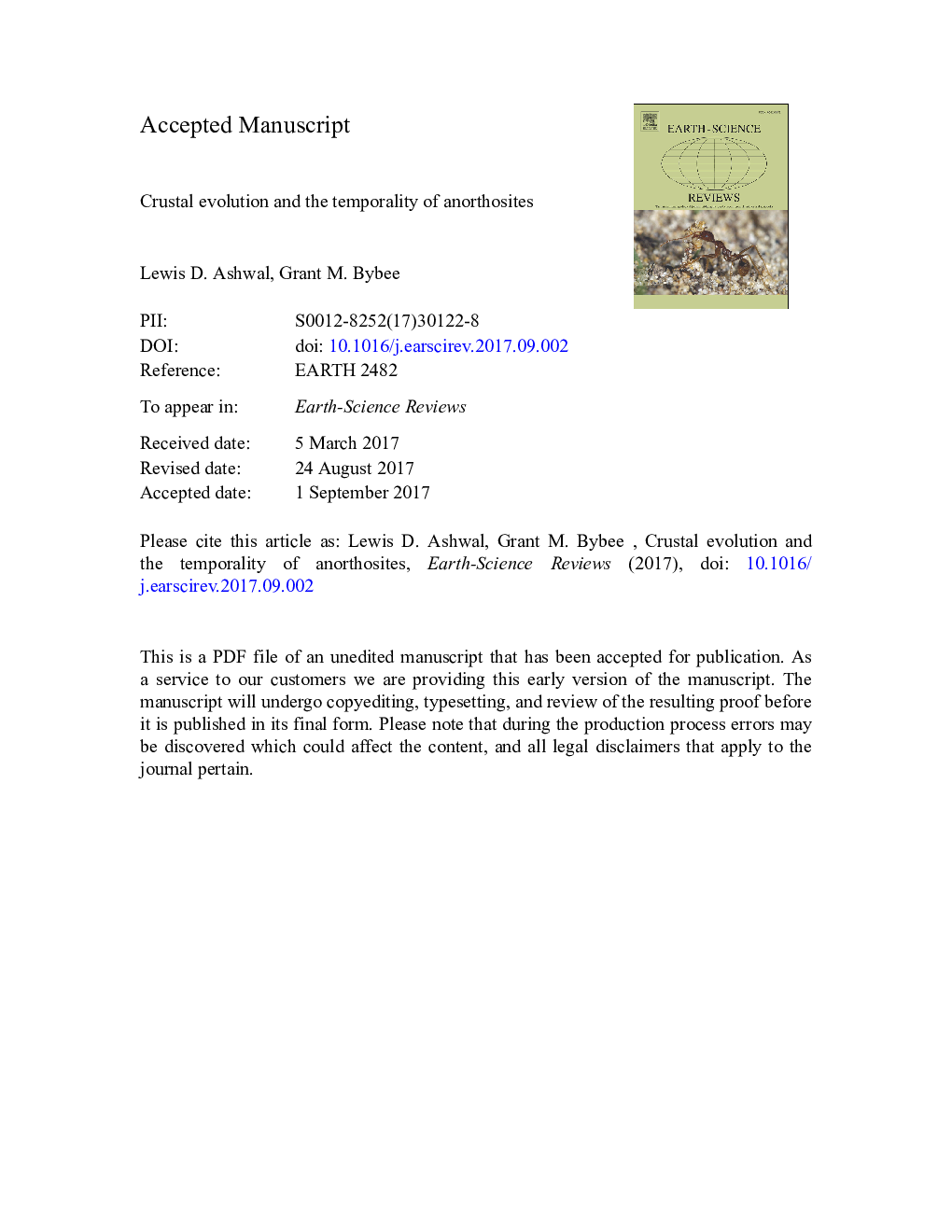| کد مقاله | کد نشریه | سال انتشار | مقاله انگلیسی | نسخه تمام متن |
|---|---|---|---|---|
| 5785063 | 1639929 | 2017 | 98 صفحه PDF | دانلود رایگان |
عنوان انگلیسی مقاله ISI
Crustal evolution and the temporality of anorthosites
ترجمه فارسی عنوان
تکامل پوسته و زمان انورتوزیت
دانلود مقاله + سفارش ترجمه
دانلود مقاله ISI انگلیسی
رایگان برای ایرانیان
موضوعات مرتبط
مهندسی و علوم پایه
علوم زمین و سیارات
زمین شناسی
چکیده انگلیسی
Types of rock, such as komatiite, which formed entirely or dominantly during restricted time periods in solar system history, are important indicators of how planetary bodies evolved in deep time. In this paper we characterize three different types of temporally-restricted anorthosites, and discuss their significance to the broad-scale evolution of planetary processes. Primordial anorthosites, which constitute the bulk of the lunar crust, were sampled during Apollo and Luna missions, and have subsequently been identified in our meteorite collections. They are characterized by very calcic plagioclase (An93-98), and all have magmatic crystallization ages >Â 4.3Â Ga, suggesting that the earliest planetary crust-forming processes on the Moon, and possibly elsewhere, involved substantial, if not total melting. The “magma ocean” hypothesis, which has endured for nearly 50Â years, argues that the lunar anorthositic rocks represent global flotation cumulates of plagioclase, which crystallized after extensive precipitation and sinking of olivine and pyroxene. Another possibility, revitalized by critical filtering of age data, involves “serial magmatism”, whereby the lunar crust was constructed by younger, smaller, episodic magmatic events. On Earth, two distinct types of temporally-restricted anorthosites offer opportunities to understand the evolution of terrestrial geodynamics, tectonics and magmatic processes. Archean megacrystic anorthosites formed only between 3.73 and 2.49Â Ga as small bodies (<Â 500Â km2) associated with the mafic magmatic assemblages of many greenstone belts. They are typified by accumulations of equidimensional, almost spherical megacrysts (1-30Â cm across) of calcic plagioclase (An61-94, avg. An80) in a mafic groundmass of broadly basaltic composition, and probably formed in shallow magma chambers. The unusually calcic plagioclase compositions may reflect crystallization from hydrous and/or Ca-rich basaltic parents that were fractionated derivatives of more primitive magmas, possibly even komatiites. Isotopic and geochemical data for many Archean anorthosite complexes indicate little to no evidence for contamination by silicic continental crust, suggesting magma formation in oceanic environments, most likely by subduction in oceanic arcs. Their temporal restriction might be explicable in terms of a hotter or wetter Archean mantle, especially if a genetic connection to komatiites can be demonstrated. Alternatively, higher Archean heat flow may have influenced oceanic crustal thickness, subduction rate, sites of magma generation and/or melt composition, producing favorable conditions for the generation of calcic megacrystic anorthosites. Proterozoic massif-type anorthosites are distinctly different from other anorthosite types, and occur as small plutons (1-10Â km2), to large (up to 18,000Â km2) composite batholiths, that are temporally restricted to a ~Â 2000Â m.y. period between ~Â 0.5 and ~Â 2.6Â Ga. The rocks are dominated by lath-shaped, intermediate plagioclase (An30-70, avg. An53), with lesser pyroxenes and/or olivine. There is extensive evidence from petrology, geochemistry and isotope data for variable contamination with continental crust, and the most plausible physical model involves deep-crustal ponding of basaltic magmas, crystallization and sinking of mafic silicates, and eventual flotation of buoyant plagioclase. Massifs were constructed by the coalescence of plagioclase-rich mushes, which ascended to mid-crustal emplacement sites. The basaltic parent melts or magmas for massif-type anorthosites were mantle-derived; alternative models involving melting of crustal sources, mafic or otherwise, cannot be supported. Collective features most readily support an Andean-type continental arc setting, and careful geochronology is beginning to suggest that magmatism in individual massifs may have occurred over long time-scales of up to 100Â m.y. The onset of massif-type anorthosite formation at ~Â 2.6Â Ga probably reflects global secular cooling of the Earth, resulting in increased lithospheric strength and crustal thickness, which promoted Moho-depth ponding and slow crystallization of basaltic magmas in continental arc environments. The apparent disappearance of anorthosite massifs at ~Â 0.5Â Ga may also relate to global secular cooling that changed the thermal structure of subduction zones, and promoted the onset of high and ultra-high pressure metamorphism.
ناشر
Database: Elsevier - ScienceDirect (ساینس دایرکت)
Journal: Earth-Science Reviews - Volume 173, October 2017, Pages 307-330
Journal: Earth-Science Reviews - Volume 173, October 2017, Pages 307-330
نویسندگان
Lewis D. Ashwal, Grant M. Bybee,
